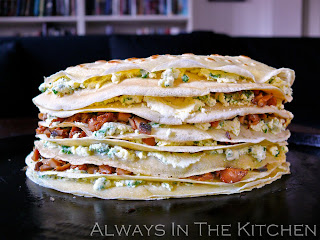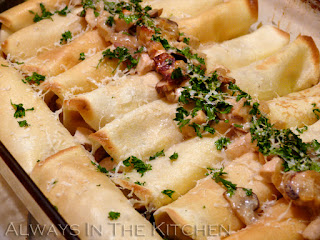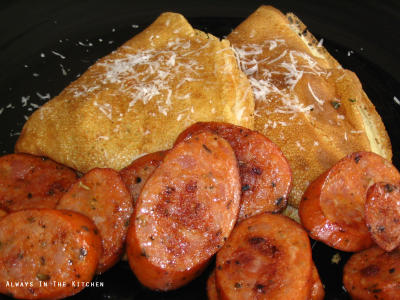
This wonderfully easy dish is one of the hearts of French country cooking. There is a bit of prep, and a rather long simmering time - but one that requires little effort from the cook. The end result is incredibly tender poached chicken, an assortment of vegetables, and an outstanding stock that can be served with the dish (pooled around the chicken and vegetables), alongside the dish (in a small bowl or cup), or kept aside for any other use you might have for a large quantity of fragrant, intense chicken stock.
Poule au Pot (Chicken in the pot) is the very close cousin of
Pot au Feu (Pot on the fire) which is essentially the same dish by method, but made with beef instead of chicken and slightly different seasonings. There are a lot of variations of
Poule au Pot, but I have chosen a fairly classic combination of vegetables. Some versions include a ground meat stuffing for the chicken, but I decided that it would be plenty of food on its own, and instead used the chicken cavity to hold the fresh thyme safely out of the way of the cooking vegetables.
When I was researching the recipe, I discovered a lot of references to a (poorly documented) speech by France's King Henry IV declaring the goal of "a chicken in every labourer's pot" - for certain values of labourer, anyway. A more modern example of the sentiment is found in Herbert Hoover's US presidential campaign in 1928, in the form of a circular promising "a chicken in every pot and a car in every garage."
There are a lot of ways to boil a chicken; I was honestly a bit skeptical of the long simmering time, given my almost complete conversion to the steeping method for cooking poultry. But the chicken is not cottony or tough. In fact, the chicken falls from the bones so easily that one should pay attention when separating the meat from the bones and what we like to call the grebbly bits.
I chose to serve this one with a white, roux-based sauce which I have seen named variously Sauce Blanche, Sauce Ivoire, and Sauce Suprême, amongst others. It is made with a velouté, using some of the stock from cooking the chicken, an egg yolk, milk, and crème fraîche. Recipe for my version of the sauce follows the
Poule au Pot recipe below. We originally draped the sauce only over the chicken, but subsequently added it to the vegetables, too.
Speaking of the vegetables, I only cooked enough vegetables for two servings, which is why the
mise en place looks a little light in the pictures below. Increase the number of vegetables as needed (or as your cooking pot allows).
Poule au Pot
Serves 4 - 6
1 whole chicken
water, enough to almost cover the chicken in a dutch oven
1 tablespoon coarse salt, plus extra salt to exfoliate the chicken
1 medium onion
4 whole cloves (spice)
3 - 4 sprigs fresh thyme
2 bay leaves
4 medium potatoes
8 small carrots
4 small turnips
2 small leeks
2 stalks celery
4 cloves garlic
Step 1: exfoliate the raw chicken. This is a technique I learned from Singaporean cuisine (specifically, Hainanese Chicken). First, remove any pinfeathers or feather debris from the chicken skin. Take a handful of salt (preferably smooth-surfaced coarse salt, such as pickling salt, to avoid tearing the skin), and massage it thoroughly into the chicken. All over. This is best done over a sink, so you can let the salt fall freely down the drain for easy clean up. When the chicken skin is smooth and tight-looking, rinse the salt from the chicken, drain and place the chicken in a large cooking pot (I used a dutch oven).
Step 2: Stuff the thyme into the cavity of the chicken, and tie the legs closed. Wash all of the vegetables thoroughly, and peel or trim where needed. Remove the dark green parts of the leeks and tuck them (and the feathery tops from the celery) around the chicken. Peel and quarter the onion, and stick the outer layer of each quarter with a clove. Add the onion quarters to the pot. Add the bay leaves to the pot. Gently pour cold water over the chicken until it is almost covered, with just the top of the breast above water.

Step 3: Turn the heat on high, and cover the pot until the water starts to just barely boil. Remove the lid and skim away any grey scum that may rise to the surface (there will be a lot less scum if you have exfoliated the chicken - I only needed to wipe the inside edge of the pot with a towel). Turn the heat to low, cover the pot again, and let simmer very gently for
80 minutes. Check it from time to time, and it if is bubbling too vigorously on the lowest temperature, leave the lid cocked to release some of the heat. You can use some of this time to peel and trim the vegetables.

Step 4: Use tongs or a slotted spoon to removed the leek tops from the pot. You can discard them (they are fibrous and have given up all of their flavour to the stock already). Raise the heat under the pot, and carefully add the raw vegetables to the pot, tucking them around the chicken if possible. If you really need more space, you can lift the chicken up (carefully!) and put the raw vegetables underneath it. More of the chicken will stick out of the water, but that's fine. If you need to remove some of the liquid to avoid the pot from overflowing, scoop some of the broth out with a measuring cup into a clean bowl or mug. The raw vegetables will cool the broth, which is why you've turned the heat up. When it begins to bubble once more (gently!) turn the heat back to minimum and cover the pot. Continue to cook for another
30 minutes (35 minutes if your potatoes are as large as these ones).

Step 5: While the vegetables finish cooking, and make the Sauce Suprême (see below). Warm some shallow bowls or plates, if necessary.
Step 6: Test the potatoes for doneness with a fork, and if they are not ready, continue to cook for another five or ten minutes, as needed. When they are cooked through, use a slotted spoon and/or spider to gently remove the vegetables and the chicken from the stock, being careful not to crush them.

Arrange on a platter if serving at the table, otherwise, divide the vegetables between the individual bowls. Carve the chicken into quarters (or sixths) and distribute amongst the bowls. You can add a little of the chicken stock to the bottom of each bowl, if you like. Spoon a little sauce over the chicken, and garnish with freshly ground black pepper. Serve with extra sauce on the side, if you like.
Accompany with a crisp white wine.
Sauce Suprême
Serves 4 - 6
30 grams salted butter
30 grams flour
400 mL chicken stock (or a combination of chicken stock and whole milk)
1 egg yolk
200 grams crème fraîche
In a small saucepan, melt the butter and stir in the flour. Cook and stir over medium heat for about five minutes, but don't let the roux darken. Add the chicken stock to the roux, slowly, whisking constantly, until smooth, and then turn the heat to low. Add a spoonful of the crème fraîche to the egg yolk, and stir to combine. Add the yolk mixture into the sauce, and whisk until thoroughly incorporated. Add the rest of the crème fraîche, and stir it through. Keep the mixture on low heat, stirring, and let it heat thoroughly, but do not let it boil. If you see any bubbles at all, remove the pot from the burner entirely. The sauce can stand while it awaits the chicken and vegetables to be ready.
One final note - you can of course customize the vegetables, and even the seasonings, to your taste. I've seen versions with green cabbage (blanche, before adding to the pot, to defeat the infamous "cabbagey smell"), rutabaga, parsnips, fennel bulb, tarragon, parsley, and shallots. Sweet potato might be nice, too. Essentially, any vegetable you'd like in a stew, you can pretty much use here. If you are not a fan of potatoes, feel free to omit them from the recipe and instead cook up some rice on the side (or do both if you just really like carbohydrates). Plain rice or mushroom pilaf both appear to be popular choices.




































